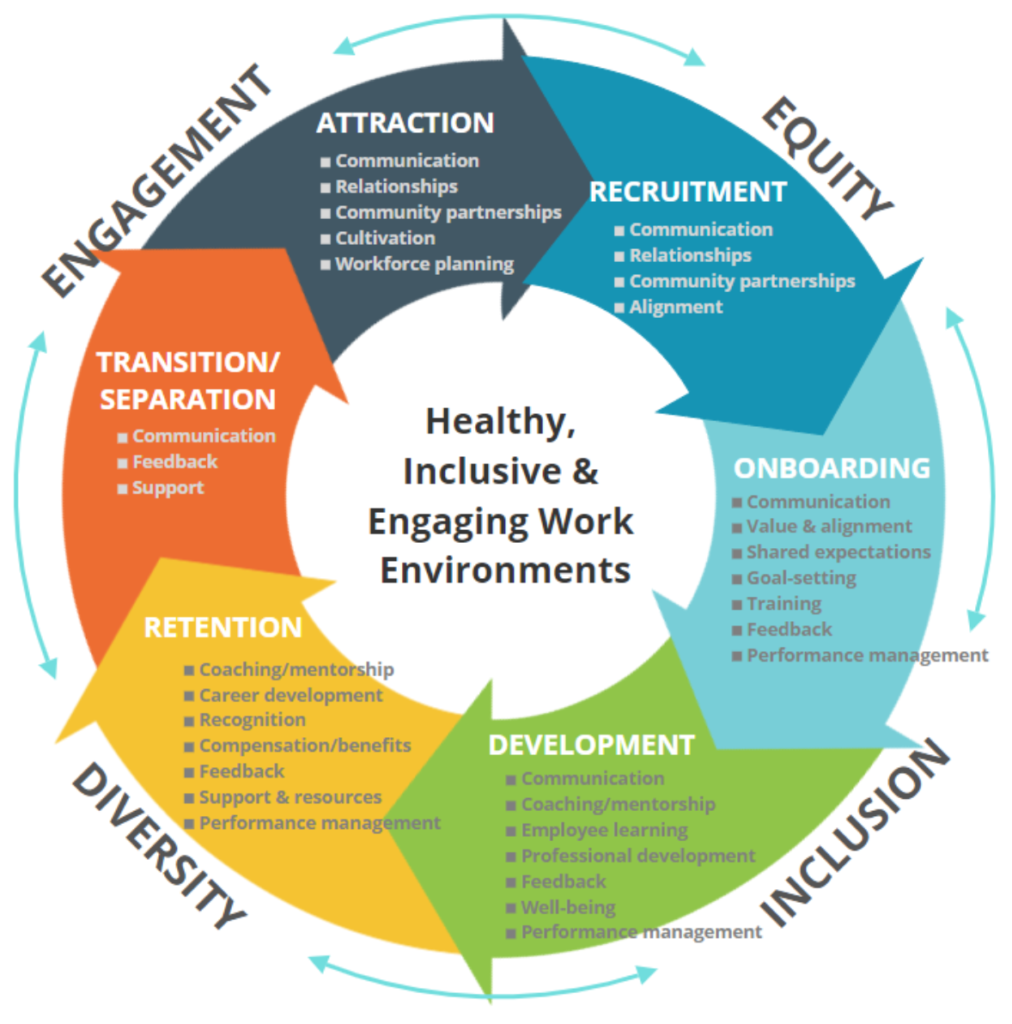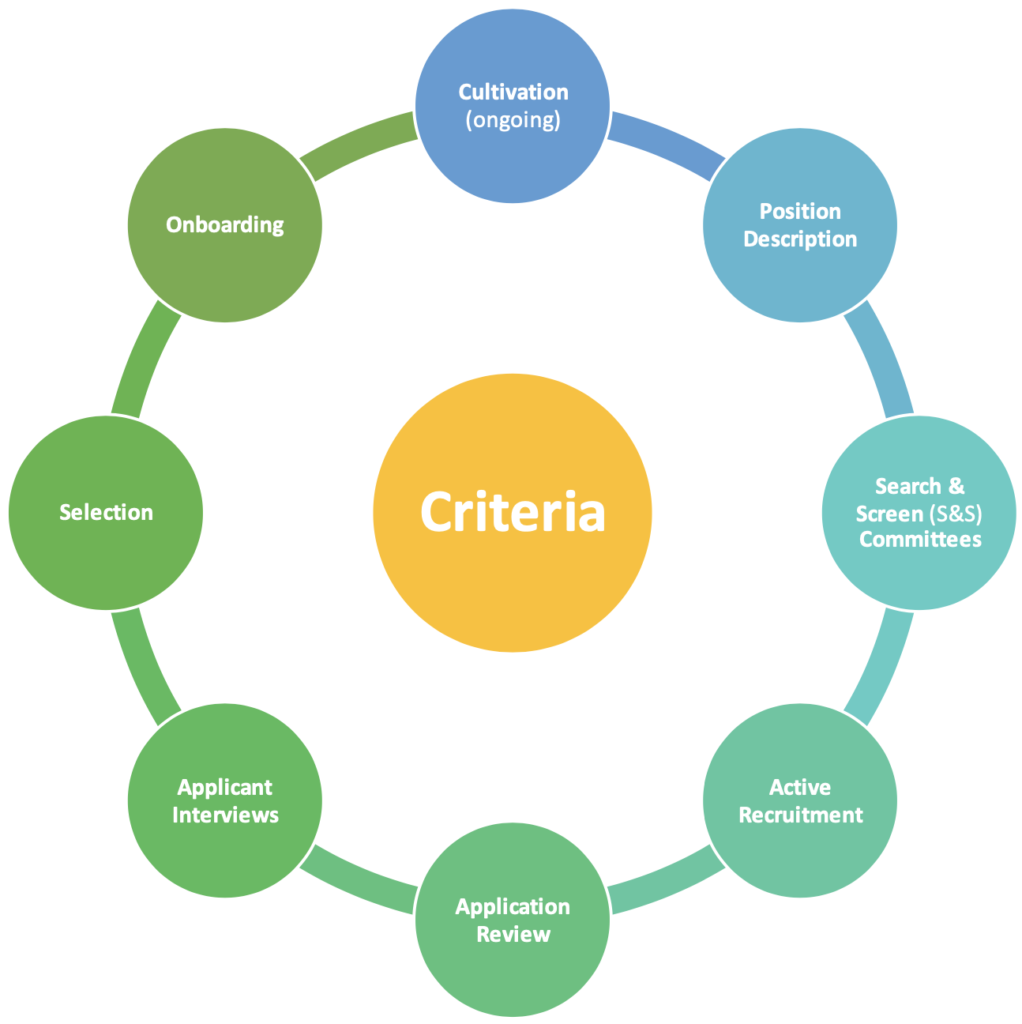
From a human resources perspective, it will be important to first understand the employee experience and the ways in which employees interact and engage with the organization — attraction, recruitment, onboarding, development, retention, and transition. This will help ensure that equity, inclusion, diversity and well-bring are embedded into everyday work policies, structures, environments, and practices. See the employee lifecycle below as a model.
Attraction and recruitment
Attraction and recruitment are opportunities to meet and engage new and diverse talent. These phases of the employee lifecycle are often the first time employees engage with the institution and in many ways these phases are the most influential time to develop relationships with potential employees to ultimately hire a talented and diverse workforce. This phase is ongoing and should be built into the organizational culture. It’s important to consider the following during these phases of the employee lifecycle.
- Communication
Clear, consistent, transparent, and personalized communication with potential employees is critical during these phases of the employee lifecycle. How and to what extent are you engaged in clear, consistent communication with potential employees? It’s important for employees to fully understand the organization, the organizational culture, and the people that make up the organization before they make a decision to join an organization. How and to what extent is information about the organization shared and communicated with potential employees?
- Cultivation and relationships
Cultivating, fostering, and sustaining strong relationships with potential employees can often make the difference between whether someone decides to apply for a job and join a new organization or not. Developing and cultivating relationships takes commitment, time, and mutual trust. How and to what extent are you engaging in developing and sustaining relationships with potential employees?
- Community partnerships
Partnering with various community organizations and networks allows organizations to easily expand their reach to potential applicants and employees, particularly when open positions are available. It will be important to consistently identify and develop partnerships that align with the organization’s mission, vision and values. When recruitments are active, leveraging these partnerships can have a great influence on how potential applicants learn about open positions, the recruiting organizations, and how they may be able to grow within those organizations.
- Workforce planning
Awareness and understanding of the current organizational makeup and workforce needs will help inform strategic recruitment planning. How and to what extent are you regularly collecting and analyzing workforce data, trends and needs to develop a targeted approach to recruitment and hiring?
- Alignment
Recruitment and workforce planning should align with the organization’s mission, vision, values and goals, particularly as they relate to employee equity, diversity, inclusion and well-being. How and to what extent are your recruitment and workforce planning goals and efforts aligned with the overall organization strategy and commitment?
Recruitment Lifecycle

The recruitment lifecycle is a process in which an applicant moves through the recruitment and hiring process. This process is a recommended workflow to intentionally review, assess, and change current processes to yield a robust and diverse applicant pool and to ensure an equitable recruitment and hiring process.
- Cultivation (ongoing)
How and to what extent is your department or unit consistently and actively cultivating a racially diverse talent pool?
- Position description
How and to what extent is your department or unit intentionally writing position descriptions that are racially equitable and framed around skills?
- Search and screen committees
How and to what extent is your department or unit building a racially diverse S&S committee? How is the committee engaged throughout the recruitment process?
- Active recruitment
How and to what extent is your department or unit moving beyond traditional recruiting methods to ensure a racially diverse applicant pool and that all communities know about and have a chance to apply?
- Application review
How and to what extent is your department or unit reviewing applications intentionally, inclusively, and equitably?
- Applicant interviews
How and to what extent is your department or unit planning, coordinating, and conducting applicant interviews intentionally, inclusively, and equitably?
- Selection
How and to what extent is your department or unit making decisions on final candidates to yield a racially diverse workforce?
- Onboarding
How and to what extent is your department or unit’s onboarding process equitable to new hires? How and to what extent does your onboarding process account for racially diverse lived experiences?
Onboarding
Onboarding is a process and journey in which newly hired employees learn about and are integrated into an organization.
- Communication
How and to what extent is information shared with new and incoming employees? How is the department or unit notified when new employees are joining the department or unit? How and to what extent are colleagues engaged in the onboarding process?
- Values and alignment
How and to what extent are organizational values shared and affirmed for new and current employees?
- Shared expectations
How are you co-creating and documenting shared expectations for new employees and supervisors of new employees? How are shared expectations reviewed and changed as needed?
- Goal-setting
How are new employees engaged in developing goals for themselves and within teams? How are goals reviewed?
- Training
When and how are new employees trained on day-to-day operational responsibilities? When and how are new employees engaged in conversation to co-create professional development learning goals and plans?
- Feedback
How and to what extent do you engage in conversation to give and collect feedback from new employees? How and to what extent is feedback used to change processes/procedures to better meet the needs of new employees and the organization?
- Performance management
How and to what extent do you engage in consistent and meaningful performance management conversations? How and to what extent are new employees involved in the co-creation and accountability of goals?
Development
Employee development is a joint partnership between an employee and an employer that is intended to support and cultivate the personal and professional growth of an employee within the organization.
- Communication
How and to what extent are you engaged in conversations to co-create development goals and plans for employees? How and to what extent do employees feel supported with their development interests and goals?
- Coaching/mentorship
How and to what extent are you intentionally providing or connecting employees to coaching or mentorship opportunities (as a mentee or mentor)?
- Employee learning
How and to what extent is learning embedded into the overall employee experience? How and to what extent is ongoing employee learning supported?
- Professional development
How and to what extent are professional development opportunities supported by the organization? By managers? By teams? How and to what extent are professional development opportunities tailored to meet the needs of employees?
- Feedback
How and to what extent is there space for managers and employees to engage in conversation to discuss feedback about professional development needs and support?
- Equity and well-being
How and to what extent is equity and well-being embedded in development opportunities?
- Performance management
How and to what extent are professional development goals, needs, and support discussed as it relates to performance management?
Retention
Employee retention is an organization’s goal and process to prevent employees from leaving the organization by fostering an organizational culture and environment where employees are valued and engaged.
- Coaching/mentorship
How and to what extent is coaching and mentoring embedded into an employee’s experience within the organization?
- Career development
How and to what extent are employee career goals discussed and supported?
- Recognition
How and to what extent are employees recognized for their work and contributions? How and to what extent are employee recognition needs being met?
- Compensation/benefits
How and to what extent does compensation and overall employee benefits align with employee contributions, workload (seen and unseen), and service to the institution?
- Feedback
How, to what extent, and how often does the organization engage in collecting and utilizing feedback in meaningful ways?
- Support and resources
How and to what extent does the organization provide ongoing support and resources to employees for them to grow and thrive in the workplace? How and to what extent do employees have access to said support and resources? How are support and resources assessed to ensure that they are meeting employee needs?
- Performance management
How and to what extent are performance conferences centered around the needs of employees? Are there opportunities for employees to engage in these conversations meaningfully? Are employees supported in their own professional goals?
Transition/separation (offboarding)
Employee transition or separation from an organization refers to a process and a point in time when an employee leaves an organization. Employees can leave organizations for numerous reasons.
- Communication
How and to what extent are organizations clearly communicating expectations and needs with employees transitioning out of the organization? How and to what extent is a transition plan co-created and documented to sustain the work the employee has been engaged in?
- Feedback
How and to what extent are organizations holding space and thoughtfully collecting feedback about the employee experience when an employee leaves the organization? How and to what extent is information collected about why employees are choosing to leave? How and to what extent is information used to improve overall employee experiences and organizational culture?
- Support
How and to what extent are employees supported throughout the transition process? How and to what extent are outgoing employees recognized for their contributions?